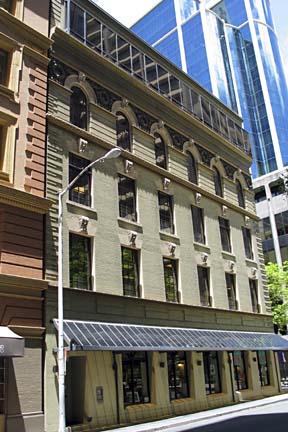
[ A Walking Tour ]
Judd Building
had Hawaii’s first
passenger elevator
Another one of Oliver Traphagen's artful pastiches of Italian Renaissance decor and stately, businesslike proportions, the Judd Building featured the first passenger elevator in Hawaii when its four floors opened in 1898. A fifth floor was plopped on top in the 1920s.
Much of the building's interior was remodeled in 1979.
Located at the corner of Merchant Street and Fort Street Mall, it's two buildings away from both the grand Alexander & Baldwin Building and the Bank of Hawaii skyscraper, with which it has shared corporate histories -- the Judd served as A&B's first headquarters, beginning in 1900 and also was Bank of Hawaii's home until 1927. In 1998, Bank of Hawaii bought the building and sold it the following year to A&B.
The Judd is a brick-faced concrete structure, and the middle floors retain much of its original charm, with arched windows and simulated keystones in a horizontal band decorated with wreaths and floral designs. The brick work was applied to approximate rustic Renaissance structures. The first and fifth floors have been modernized with the addition of large plate-glass windows and plastic overhangs.
Judd Building
Architect:
Oliver TraphagenOpened:
1898, remodeled 1979Address:
851 Fort Street MallNational Register:
1973Hawaii Register:
No
BACK TO TOP |
BURL BURLINGAME / BBURLINGAME@STARBULLETIN.COM
The middle three floors of the Judd Building are pretty much the way they were designed by Oliver Traphagen in 1898.
BACK TO TOP |
Quicktime VR Panorama
Click on pictures to view panaromas

BURL BURLINGAME / BBURLINGAME@STARBULLETIN.COM
Every Sunday in the Star-Bulletin Travel section, rediscover the charms of old Hawaii through a tour created by the Honolulu Historic Trail Committee and Historic Hawai'i Foundation and supported by the city's Office of Economic Development. The yearlong project commemorates Honolulu's bicentennial.
BACK TO TOP |
See Honolulu City Highlights
Various Honolulu historical organizations have clamored for years to have some sort of survey created of downtown Honolulu's historical sites. The mayor's Office of Economic Development stepped in last year to create order, and 50 locations were chosen as representative of Honolulu's history.
There is, of course, far more history in Honolulu's streets than indicated here, but these sites give the high points and can be visited on a walking tour lasting about three hours.
To commemorate Honolulu's bicentennial, the Star-Bulletin kicks off "Holoholo Honolulu" today, a year-long project to examine these historic properties. For the next 50 Sundays in the Travel section, stories and photographs will illuminate these sites.
But that's just the tip of the architectural iceberg. Viewers can step right into these locations via the magic of QuickTime Virtual Reality, a computer process that allows visitors from around the world to feel as if they're standing right there on the street.
WE'RE ALSO looking for old photographs of these sites to scan for public use. If you have anything, let us know:
Write to:
Holoholo
Honolulu Star-Bulletin
7-210 Waterfront Plaza
500 Ala Moana
Honolulu, HI 96813.E-mail:
bburlingame@starbulletin.com


